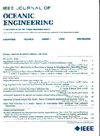模拟海洋动力学和参数估计的物理信息神经网络:利用海洋再分析数据
IF 5.3
2区 工程技术
Q1 ENGINEERING, CIVIL
引用次数: 0
摘要
海洋再分析和卫星遥感产品的进步为利用大规模数据集分析和模拟海洋动力学提供了前所未有的机会。本文利用中国海洋再分析第二版(CORA2)数据集对中国东海岸的海洋动力学进行了建模和参数估计。创新地提出了一种将物理信息神经网络与基于特征的分裂相结合的新方法,以有效地分析开放边界条件下的表面波和潮汐等动力学问题。该方法利用中国沿海地区的多个时间序列流场数据估算来波边界幅值,并利用这些估计值预测未来流场的变化。通过与CORA2数据集的对比,证实了该方法具有较高的精度和可靠性,并且通过纳入海底摩擦系数估计值,显著改善了模式预测与实际观测数据的一致性。这揭示了结合物理方程使用大规模数据集来提高海洋动力学建模精度和计算精度的有效性。本文章由计算机程序翻译,如有差异,请以英文原文为准。
Physics-Informed Neural Networks for Modeling Ocean Dynamics and Parameter Estimation: Leveraging Ocean Reanalysis Data
Advancements in ocean reanalysis and satellite remote sensing products have opened unprecedented opportunities for using large-scale data sets to analyze and model ocean dynamics. This article utilizes the China Ocean Reanalysis Second Edition (CORA2) data set to model and estimate parameters for the ocean dynamics off the East Coast of China. A novel approach combining physics-informed neural networks with characteristic-based split is innovatively proposed to effectively analyze dynamics issues, such as surface waves and tides under open boundary conditions. This method estimates the boundary amplitude of incoming waves using multiple time-series flow field data from coastal areas in China, and uses these estimates to predict future flow field changes. By comparing with the CORA2 data set, the method not only confirms its high accuracy and reliability but also significantly improves the alignment between model predictions and actual observational data by incorporating estimates of seabed friction coefficients. This reveals the effectiveness of using large-scale data sets in conjunction with physical equations to enhance the accuracy and computational precision of ocean dynamics modeling.
求助全文
通过发布文献求助,成功后即可免费获取论文全文。
去求助
来源期刊

IEEE Journal of Oceanic Engineering
工程技术-工程:大洋
CiteScore
9.60
自引率
12.20%
发文量
86
审稿时长
12 months
期刊介绍:
The IEEE Journal of Oceanic Engineering (ISSN 0364-9059) is the online-only quarterly publication of the IEEE Oceanic Engineering Society (IEEE OES). The scope of the Journal is the field of interest of the IEEE OES, which encompasses all aspects of science, engineering, and technology that address research, development, and operations pertaining to all bodies of water. This includes the creation of new capabilities and technologies from concept design through prototypes, testing, and operational systems to sense, explore, understand, develop, use, and responsibly manage natural resources.
 求助内容:
求助内容: 应助结果提醒方式:
应助结果提醒方式:


